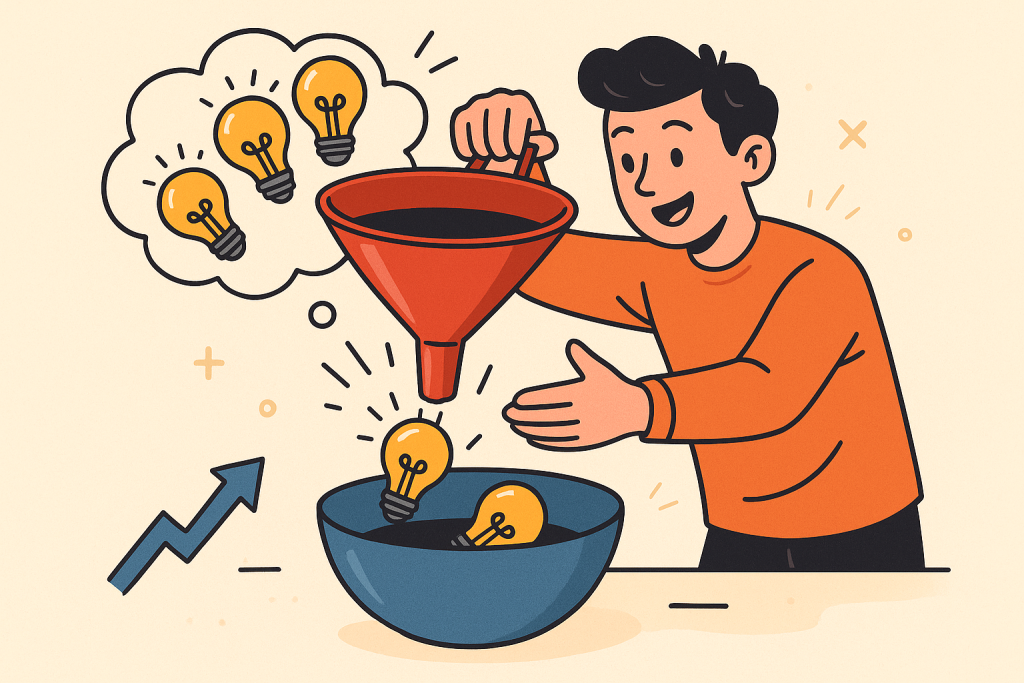In the age of constant innovation, creative chaos is the new norm. Whether you’re a startup founder, content creator, or project manager, the challenge isn’t generating ideas—it’s filtering them fast without killing the vibe. In a world where every second counts, learning how to filter ideas without losing momentum is not just a productivity hack; it’s a survival skill.
Let’s break down how high-performing teams and creators stay in flow, trim the fluff, and keep the fire alive.

The Innovation Trap: When More Ideas Mean Less Action
Creative teams are flooded with ideas—emails, brainstorming sessions, Slack threads. But too much of a good thing can quickly become the enemy of execution.
According to a Harvard Business Review study, “idea overload” can delay decisions and cause mental fatigue, particularly when there’s no structured filtering process in place (HBR, 2022). The result? Teams get paralyzed, great concepts get buried, and momentum grinds to a halt.
Here’s the truth: Most teams don’t need more ideas. They need a system to spot the right ones faster.
Trend Alert: Lean Prioritization Is the New Brainstorm
One of the most exciting trends in modern workflows is the shift toward lean prioritization. Inspired by Agile frameworks, this method encourages teams to place ideas into structured buckets: Must-Have, Nice-to-Have, and Future-Bets.
Key benefits:
- Speeds up decision-making
- Reduces meeting fatigue
- Keeps teams aligned on goals
Tools like Trello, Notion, and ClickUp now integrate AI to assist in idea ranking based on goal alignment and potential impact, offering quick visual feedback and helping maintain momentum (TechCrunch, 2024).
5 Fast Filtering Tactics That Actually Work
Here’s how to filter ideas without losing momentum, using real-world proven methods:
1. The 10-Minute Funnel
Set a timer. Every team member gets 2 minutes to pitch. Once the timer’s up, you must cut 50% of the list. No debate—just action.
2. Use the ICE Framework
Score each idea by:
- Impact: Will it move the needle?
- Confidence: How sure are you?
- Ease: Is it doable quickly?
Rank ideas from highest to lowest. The top 3 move forward.
3. Kill Your Darlings
A creative writing principle that applies beautifully here: Remove the ideas you’re emotionally attached to. Emotional bias often clouds real value.
4. The MVP Filter
Ask: Can we test this in under 1 week with minimal resources? If not, table it for now.
This keeps momentum high and avoids scope creep.
5. Real-Time Voting Tools
Tools like Miro, MURAL, and Poll Everywhere allow anonymous team voting in real time. This reduces hierarchy bias and speeds up consensus.
The Power of Timeboxing
Here’s an expanded and elaborated version of the excerpt you mentioned:
Why Timeboxing Is Revolutionizing Team Efficiency
In today’s high-speed work environments, the fastest and most successful teams operate on tight feedback loops. These teams thrive not by perfecting every detail but by optimizing how they process and execute decisions. A core technique enabling this agility is timeboxing—the deliberate allocation of a fixed amount of time to complete a task or make a decision.
Timeboxing doesn’t just streamline workflow; it directly impacts productivity. According to Asana’s 2023 Anatomy of Work report, teams that implemented timeboxing strategies experienced a 27% increase in decision-making speed without any noticeable decline in the quality of ideas or outcomes (Asana, 2023). This approach creates boundaries that limit overthinking and reduce the paralyzing effects of perfectionism.
Rather than allowing discussions or planning sessions to sprawl endlessly, teams cap their time investments. This forces prioritization and encourages fast, iterative execution. In a world where responsiveness can define market winners, adopting timeboxing transforms decision-making from a deliberative process into a results-oriented discipline.
The lesson is clear: perfection can be a bottleneck. But structured urgency—like that fostered through timeboxing—unlocks consistent forward motion without sacrificing innovation.
Create a “Graveyard” to Honor Dead Ideas
Momentum killers often come from internal resistance—people fear their ideas are discarded without recognition. One smart tactic? Build an “Idea Graveyard.”
- Use a shared doc or board
- Archive ideas that don’t make the cut
- Revisit them quarterly
This creates psychological safety and keeps creativity flowing without clogging your active workspace.
Momentum Loves Clarity
Filtering ideas isn’t just about picking the best one—it’s about doing it fast and doing it right, especially in high-velocity environments where slow decisions cost you more than bad ones. This is where clarity becomes your secret weapon.
To maintain creative flow and execution speed while sorting through multiple ideas:
- Set Clear Criteria: Define exactly what makes an idea “viable” for your current context. Are you optimizing for speed to market, budget efficiency, innovation, or alignment with business goals? Without explicit criteria, teams spiral into subjective debates.
- Communicate the Filters: Your criteria should be known and remembered. Repeating them often turns them into a shared mental model—like guardrails that help everyone move quickly without veering off-course.
- Use Tools That Force Decisions: Structured frameworks like the ICE (Impact, Confidence, Ease) or RICE (Reach, Impact, Confidence, Effort) scoring systems push teams to assign scores and make trade-offs visible. Software like Trello, Asana, or Notion can help log and sort scores in real time.
Remember: the win isn’t just choosing the “best” idea—it’s designing a repeatable process that lets you consistently make high-quality decisions with speed. This scalability in decision-making is the true productivity multiplier
References
Harvard Business Review (2022). “When Too Many Ideas Stall Innovation.” Available at: https://hbr.org/2022/09/when-too-many-ideas-stall-innovation
TechCrunch (2024). “AI in Productivity Tools: How Notion and Trello Are Changing the Game.” Available at: https://techcrunch.com/2024/01/18/notion-ai-productivity/
Asana (2023). “Anatomy of Work Global Index.” Available at: https://asana.com/resources/anatomy-of-work






